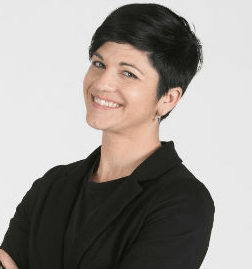Did you study another language in high school? Did these classes make you fluent?
Of course not!
Traditional methods like filling in worksheets with the correct verb conjugation and memorizing lists of words for an exam (only to forget them straight after) are not actions that lead to language acquisition.
Real life and real fluency are not found in a textbook, and rarely experienced in a traditional classroom.
So, how can you reach the fluency level you desire? How can you rid yourself of the anxiety, get out of your head, and actually connect in another language? If you follow our Bridge to Connection Method, which closely mirrors the Fluent Forever approach, you will achieve your language goals.
Bridge to Connection Method
Step 1: Access Native Materials
There is simply no excuse these days for not accessing your target language.
The key, though, is to find materials made by, and for, native speakers, not just created for students. If you only utilize material made for students, such as textbooks, you will only receive the fake, scripted language that will not help you in the real world.
Podcasts, TV shows, movies and online periodicals are available online 24/7. Now, of course, you will not understand everything at first. Perhaps you may feel discouraged, as the pace at which natives speak is faster than any teacher or scripted listening practice. Native speakers also use a lot of slang and idiomatic expressions that you have never been exposed to. This is where subtitles and transcripts come in.
Be intentional about actively improving your language abilities. Don’t just passively sit back and stare at a movie, growing more and more discouraged as you feel you don’t understand anything. Turn on the subtitles. At first, just focus on following the story, or just getting the gist. Progress is made by small steps, not enormous leaps.
While you watch, you can note down 3 to 4 vocabulary words and phrases. After the movie or TV show is finished, add these phrases to a vocabulary notebook, and use them in your own example sentence. Alternatively, you can also utilize a flashcard app. Review your personal vocabulary list a couple times a week, and make sure to USE these words out loud, even if you’re just talking to yourself.
Keep in mind as well that our brains are limited. By this I mean that we cannot learn everything perfectly, all at once. So, you must be intentional about improving. For instance, decide beforehand your goal for watching a movie or reading a newspaper article. Goals include:
- Improving pronunciation (Watch the movie for 10 seconds, pause and mimic the actor.)
- Learning new vocabulary
- Improving overall comprehension
Step 2: Take Time to Prepare
As a nonnative speaker, you cannot expect to enter conversations, understand every word that is said immediately, and be able to respond spontaneously with no hesitation.
Accept this fact and prepare beforehand.
As a nonnative, you should take a moment before entering a situation to prepare your brain for success. The main method for doing this follows Schema Theory, developed by Jean Piaget in the 1950’s. You are an adult with a life of experience, and you must use this knowledge of the world. A ‘schema’ is a mental framework, or a set of expectations based on experience, for any situation.
Say, for instance, you are attending a party. Certainly you have attended parties before. Therefore, you are familiar with the types of conversations that occur in these situations- how people break the ice and what kind of topics are discussed. Be assured that introductions and small talk vary little from country to country.
So, before you go to the party and attempt to engage in another language, plan ahead of time. Think about how you are going to introduce yourself, start conversations, or even tell a story about yourself, in this target language. You can take this one step further and actually practice these words out loud in front of a mirror before leaving the house.
Ultimately, don’t expect to participate in the world as a fully fluent native speaker. You are not that person- yet. Take these extra steps to new environments with confidence.
Step 3: Dive in!
Now it’s time to connect in your target language! If you’ve prepared correctly, you will not experience the anxiety, stage fright and paralysis that some feel when having to engage with others in a foriegn language.
Why did you start learning this language in the first place? Did you merely want to be able to complete a grammar textbook? Did you only want to memorize vocabulary… and then never use it? I hope not!
If you prepared well, you are ready to experience connections with others in your target language. Here are some tips to keep in mind:
- Be willing to take risks.
- Ask questions to keep the conversation going.
- Actually listen to what the other person is saying, instead of living anxiously in your head, worrying about being embarrassed.
- Be willing to share your personal experiences- your opinions, stories from your life, perspectives from your culture and home country.
- Most importantly, your number one priority is CONNECTION. And, for connection, perfect grammar and vocabulary is not required.
There are fantastic experiences waiting for you, in any language you choose. Don’t hide from them! Make the choice to really learn your target language in a new, more effective way than in the past, and always keep our All Ears English motto in mind: CONNECTION NOT PERFECTION.





